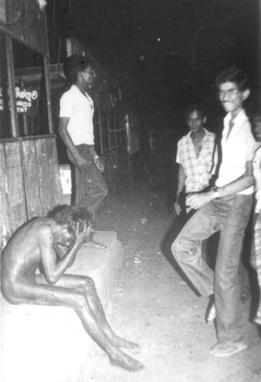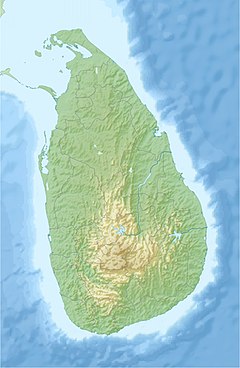
The Sri Lankan Civil War was a civil war fought in Sri Lanka from 1983 to 2009. Beginning on 23 July 1983, it was an intermittent insurgency against the government by the Liberation Tigers of Tamil Eelam led by Velupillai Prabhakaran. The LTTE fought to create an independent Tamil state called Tamil Eelam in the north-east of the island, due to the continuous discrimination and violent persecution against Sri Lankan Tamils by the Sinhalese-dominated Sri Lanka government.

The 1987–1989 JVP insurrection, also known as the 1988–1989 revolt or the JVP troubles, was an armed revolt in Sri Lanka, led by the Marxist–Leninist Janatha Vimukthi Peramuna, against the Government of Sri Lanka. The insurrection, like the previous one in 1971, was unsuccessful. The main phase of the insurrection was a low-intensity conflict that lasted from April 1987 to December 1989. The insurgents led by the JVP resorted to subversion, assassinations, raids, and attacks on military and civilian targets while the Sri Lankan government reacted through counter-insurgency operations to suppress the revolt.

Black July was an anti-Tamil pogrom that occurred in Sri Lanka during July 1983. The pogrom was premeditated, and was finally triggered by a deadly ambush on 23 July 1983, which caused the death of 13 Sri Lanka Army soldiers, by the Tamil militant group Liberation Tigers of Tamil Eelam (LTTE). Although initially orchestrated by members of the ruling UNP, the pogrom soon escalated into mass violence with significant public participation.

The 1977 anti-Tamil pogrom in Sri Lanka followed the 1977 general elections in Sri Lanka where the Sri Lankan Tamil nationalistic Tamil United Liberation Front won a plurality of minority Sri Lankan Tamil votes. In the elections, the party stood for secession. An official government estimate put the death toll at 125, whereas other sources estimate that around 300 Tamils were killed by Sinhalese mobs. Human rights groups, such as the UTHR-J, accused the newly elected UNP-led government of orchestrating the violence.
The Kent and Dollar Farm massacres were the first massacres of Sinhalese civilians carried out by the LTTE during the Sri Lankan Civil War. The massacres took place on 30 November 1984, in two tiny farming villages in the Mullaitivu district in north-eastern Sri Lanka. The Sri Lankan government labeled this as an attack on civilians by the LTTE.
The Anuradhapura massacre occurred in Sri Lanka in 1985 and was carried out by the Liberation Tigers of Tamil Eelam. This was the largest massacre of Sinhalese civilians by the LTTE to date; it was also the first major operation carried out by the LTTE outside a Tamil majority area. Initially, EROS claimed responsibility for the massacre, but it later retracted the statement, and joined the PLOTE in denouncing the incident. The groups later accused the LTTE for the attack. Since then, no Tamil militant group has admitted to committing the massacre. However, state intelligence discovered that the operation was ordered by the LTTE's leader Velupillai Prabhakaran. He assigned the massacre to the LTTE Mannar commander Victor and it was executed by Victor's subordinate Anthony Kaththiar. The LTTE claimed the attack was in revenge of the 1985 Valvettiturai massacre, where the Sri Lanka Army killed 70 Tamil civilians in Prabhakaran's hometown. In 1988, the LTTE claimed that the massacre was planned and executed under the guidance of Indian intelligence agency, RAW.
The 2006 Trincomalee Massacre of NGO Workers, also known as the Muttur Massacre, took place on 4 or 5 August 2006, when 17 employees of the French INGO Action Against Hunger were shot at close range in the city of Muttur, Sri Lanka, close to Trincomalee. The victims included sixteen minority Sri Lankan Tamils and one Sri Lankan Muslim.
Eelam War I is the name given to the initial phase of the armed conflict between the government of Sri Lanka and the LTTE.

Arunasalam Thangathurai was a Sri Lankan Tamil lawyer, politician and Member of Parliament.

The Prawn farm massacre, also known as the 1987 Kokkadichcholai massacre, took place on January 27, 1987 in the village of Kokkadichcholai, Sri Lanka. At least 83 Tamil civilians were killed. The Special Task Force, an elite special forces unit of the Sri Lanka Police specializing in counter-terrorist and counter-insurgency operations, was accused of having perpetrated the massacre. Asian Agricultural Products Limited (AAPL), the Hong Kong based part-owner of the farm filed for arbitration by ICSID, an arm of the World Bank, against the government of Sri Lanka; AAPL prevailed in the arbitration, eventually received payment and families of the victims were paid some monetary compensation.

Charles Lucas Anthony was a Sri Lankan Tamil rebel and leading member of the Liberation Tigers of Tamil Eelam (LTTE), a separatist Tamil militant organisation in Sri Lanka.

The Jaffna hospital massacre occurred on October 21 and 22, 1987, during the Sri Lankan Civil War, when troops of the Indian Peace Keeping Force entered the premises of the Jaffna Teaching Hospital in Jaffna, Sri Lanka, an island nation in South Asia, and killed between 60 and 70 patients and staff. The rebel Liberation Tigers of Tamil Eelam, the government of Sri Lanka, and independent observers such as the University Teachers for Human Rights and others have called it a massacre of civilians.
Akkaraipattu is a large town in the Ampara District, Eastern Province, Sri Lanka. The town is strategically located with links via the Siyambalanduwa-Ampara Road (A25) and the Colombo-Batticaloa highway (A4). Akkaraipattu is situated 441 km (274 mi) from Colombo.
The 1984 Mannar massacre was the killing of 200+ minority Sri Lankan Tamils civilians by Sri Lankan Army soldiers in the town of Mannar, north-western Sri Lanka, on December 4, 1984. The attack was triggered when three Army jeeps hit a land mine, killing one soldier. In retaliation, landmarks such as the Central hospital, the post office, a Roman Catholic convent as well as villagers working in rice paddy fields and bus passengers were attacked. Villages around Mannar town such as Murunkan and Parappankadal were also attacked. Immediately after the incident, the then Sri Lankan President J. R. Jayawardene appointed a Presidential commission of inquiry. A local Roman Catholic priest, Mary Bastian who was a member Presidential commission was later killed in January 1985. A Methodist minister George Jeyarajasingham, who was a witness to the incident, was also killed in December 1984.
The following lists events that happened during 1986 in Sri Lanka.

The 1987 Eastern Province massacres were a series of massacres of the Sinhalese population in the Eastern Province of Sri Lanka by Tamil mobs and Liberation Tigers of Tamil Eelam (LTTE) during the Sri Lankan Civil War. Though they began spontaneously, they became more organized, with the LTTE leading the violence. Over 200 Sinhalese were killed by mob and militant violence, and over 20,000 fled the Eastern Province. The violence has been described as having had the appearance of a pogrom.
Sexual violence against Tamils in Sri Lanka has occurred repeatedly during the island's long ethnic conflict. The first instances of rape of Tamil women by Sinhalese mobs were documented during the 1958 anti-Tamil pogrom. This continued in the 1960s with the deployment of the Sri Lankan Army in Jaffna, who were reported to have molested and occasionally raped Tamil women.







